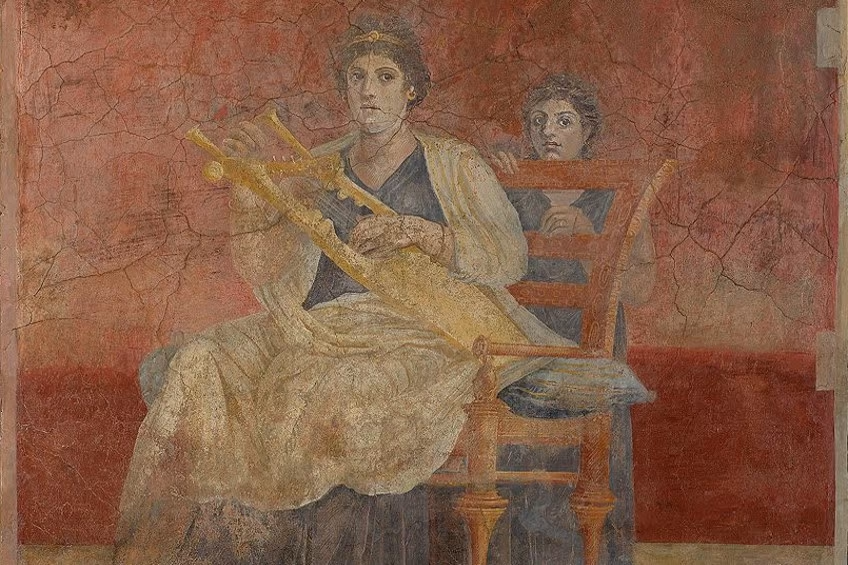Famous Roman Paintings – Discover Ancient Roman Art Pieces
The people of ancient Rome made a significant impact on the development of religion, technology, language, literature, and art. Ancient Roman art consisted of paintings, pottery, sculpture, and architectural forms. This article will take you on a time-traveling journey back to ancient Rome and outline some of history’s best paintings of ancient Rome.
Famous Roman Paintings
Art in ancient Roman culture takes you through multiple themes ranging from portraits to animals, still lifes, daily life, and mythology. As expected of art from any era, ancient Roman art depicted elements of Roman culture that were significant and generally known.
Erotic imagery is also featured in ancient Roman art, as well as countryside images such as temples, shepherds, cattle, and rural landscapes.
When referring to ancient Rome, we include the period from the beginning of Roman civilization around the eighth century BC until the fall of the Western Roman Empire around 5 AD. This also includes periods of the Roman kingdom, republic, and empire. The history of ancient Rome is often classified under classical antiquity for its interconnected relationship with ancient Greece on the Mediterranean Sea.
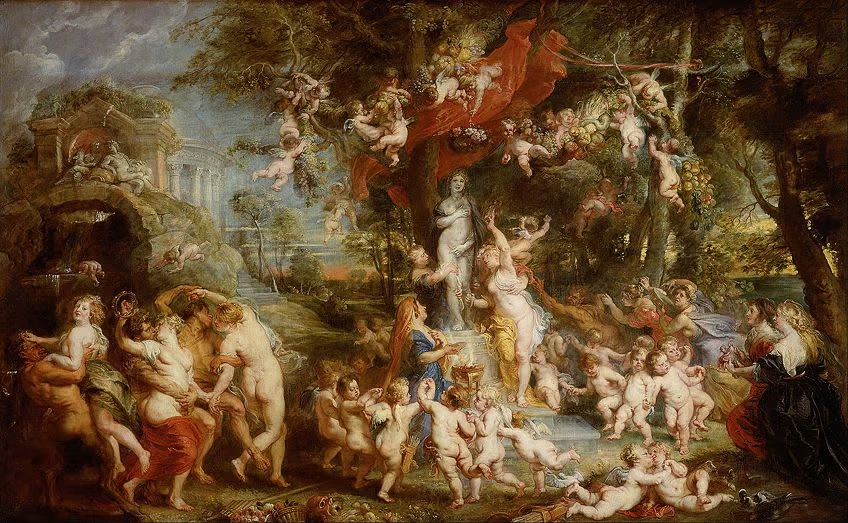 The Feast of Venus (1636 – 1637) by Peter Paul Rubens, located in the Kunsthistorisches Museum in Vienna, Austria; Peter Paul Rubens, Public domain, via Wikimedia Commons
The Feast of Venus (1636 – 1637) by Peter Paul Rubens, located in the Kunsthistorisches Museum in Vienna, Austria; Peter Paul Rubens, Public domain, via Wikimedia Commons
It is also important to note that ancient Rome dominated other territories other than the Italian Peninsula and expanded its territory into Egypt, Crimea, Arabia, most of the Middle East, Southern and Western Europe, as well as the Balkans, Levant, and Anatolia, all conquered by the Roman Empire. Returning to ancient Roman art, painting was one of the most diverse art forms for the depiction of numerous subjects, from landscapes and portraits to triumphal and genre paintings.
Many of the famous Roman paintings and imagery from artworks have been replicated as contemporary Roman drawings and can be seen executed as prints by many talented artists.
While the study of Roman drawings is not investigated as in-depth as the study of Egyptian drawings, there are a few architectural drawings and representations that can be studied from the great Temple of Apollo at Didyma. Some of the most famous sites that left behind Roman art include Pompeii wall paintings, the Catacombs of Rome, and the Herculaneum. Below, we will look at a few famous ancient Roman paintings while discussing the styles of painting expressed during the time.
The Painted Garden Fresco at the Villa of Livia
| Date | 30 – 20 BCE |
| Medium | Fresco |
| Where It Is Housed | Museo Nazionale Romano, Palazzo Massimo, Rome |
The Villa of Livia contains one of the most well-known Roman wall paintings in ancient Roman art history. Livia Drusilla, the wife of Caesar Augustus, had her own dwelling or resort-like abode known as the Villa of Livia. In this home, there was a room that was constructed partially underground and dug into a rock, thus allowing for cooler temperatures during the summer months.
The coolness of the room was accompanied by the equally serene and cool artwork on the walls, which depicted the illusion of a garden landscape.

The garden landscape featured various fauna, flora, and birds. The beauty of the illusion of the garden landscape lies in the details of the wall painting. Some of the trees and bushes are rendered with more detail and contrast than those fading into the background.
This adds an extra sense of depth to the room, which with cooler temperatures and colors, completely immerses the viewer in a playful environment among nature.
This is also not just a painting of a garden but a revival of the life and variety found within a garden. The artist made sure to include different fruits and various plant species such as iris, oak, umbrella pine, red fir, quince, myrtle, pomegranate, oleander, strawberry, date palm, laurel, holm oak, cypress, viburnum, boxwood, ivy, acanthus, poppy, chamomile, chrysanthemum, rose, fern, and violet.
The Dionysiac Frieze of Pompeii
| Date | c. 50 BC |
| Medium | Fresco |
| Dimensions (m) | 3.3; 1.5 (figures) |
| Size (m²) | 54 |
| Where It Is Housed | Villa dei Misteri, Pompei, Italy |
The Dionysiac Frieze is another famous Roman painting situated in the city of Pompei at the Villa of Mysteries. In the room where the frieze is situated is also a decorative wall panel that reaches the ceiling. The frieze encompasses the entire room, illustrating slightly less-than-life-sized figures in a scene of bold red color that features violence and pageantry.
One of the key subjects in the fresco is the Greek God of wine, Dionysus, and depicted in the frieze is a ritual offering for him, hence, the name of the frieze was titled The Dionysiac Frieze.
The city of Pompeii was also victim to the tumultuous damage incurred by the eruption of Mt. Vesuvius on August 24th, 79 AD. For centuries, very little about the culture and life of this ancient civilization was known until 1999 when archaeological excavations ensued. Painted around 50 BC, the fresco was created using pigment painted directly onto the wall surface. The artist(s) made use of natural pigments such as cinnabar to create the once brilliant red background.
The artists also made use of natural architecture to create illusions in space that seem to extend beyond the confines of the room, thus, bringing to life the frieze. The home of the Dionysiac Frieze, the Villa of Mysteries, also refers to the activities that took place in the building. These are believed to be ritualistic events, which is one of the only dominant meanings behind the fresco since no one truly knows of the scene depicted in the painting.
The first scene in the fresco depicts a woman initiating a ritual or process by carrying a tray. Other scenes include a reclining Dionysus and an aged Silenus. Another interpretation of the fresco claims that this is a young woman participating in a ceremonial marriage to prepare herself for womanhood.
The Dionysiac Frieze is a great example of the style of the time that lasted between 20 and 79 AD and was defined by a less traditional approach involving large-scale paintings with narratives, panoramic-styled vistas, and some architectural details. The bright monochromatic red background is said to be a style that predated the emergence of large narrative paintings and reached its peak during the reign of Emperor Augustus.
Perseus and Andromeda in Landscape
| Date | Last decade of the first century BC |
| Period | Augustan |
| Medium | Fresco |
| Dimensions (cm) | 159.39 x 118.75 |
| Where It Is Housed | Metropolitan Museum of Art, New York City |
This Roman wall painting is one of many famous wall paintings of ancient Rome. Executed in a Roman fresco style, the wall painting showcases a landscape featuring two mythological events inspired by the story of Perseus who rescued Andromeda from the sea monster, Cetus. Cetus is seen illustrated with vivid blue-green hues as he bares his sharp teeth with a wide-open mouth towards Andromeda.
Andromeda is seen positioned with her arms outstretched in the middle of the fresco with her one hand chained to a crag and her other hand resting gently on the rocks.
Perseus is seen on the left with a lyre in hand, adorned in his classic winged shoes and cloak thrown over his shoulder. Towards the right of the fresco is Andromeda’s father, which draws reference to the story’s happy ending and the successful marriage of the two.
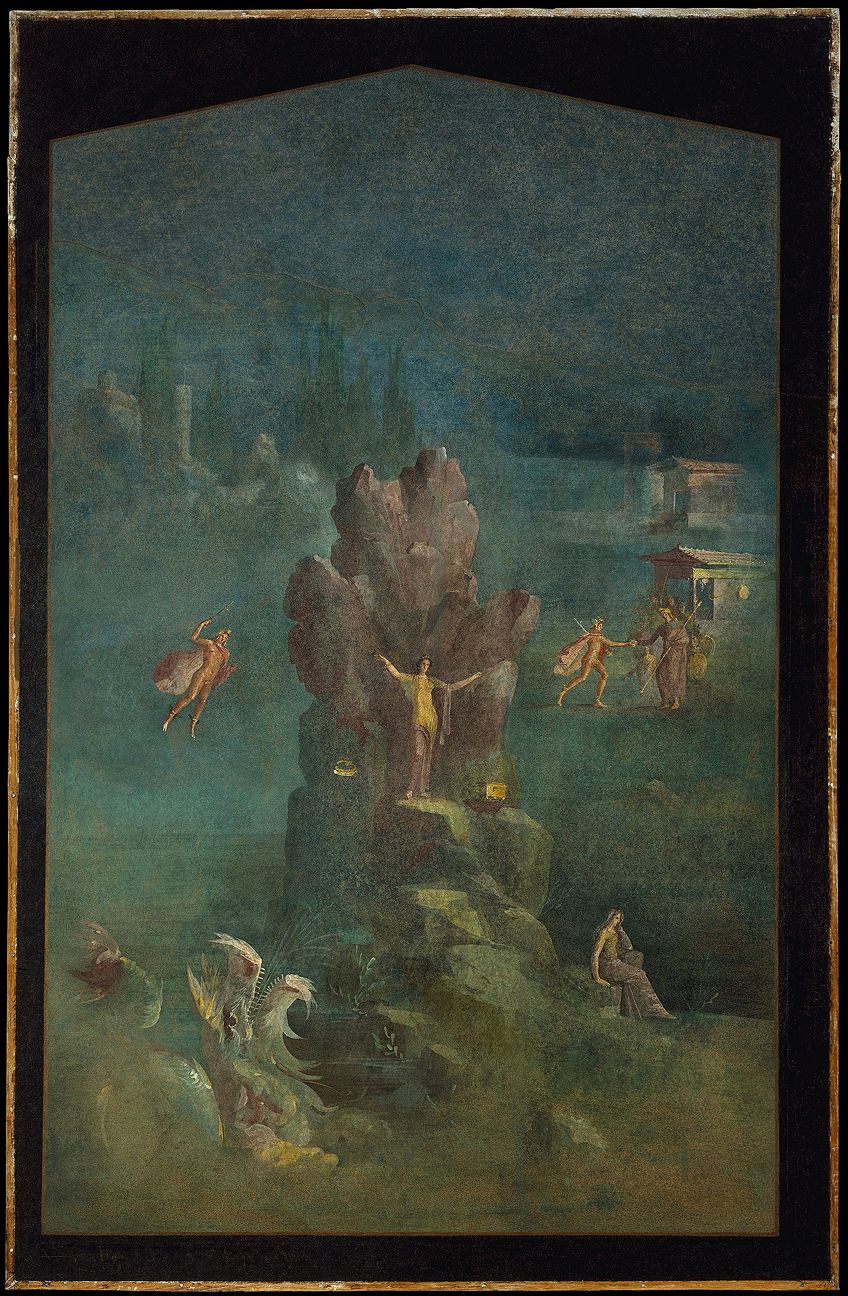
Most ancient Roman paintings consisted of wall paintings executed directly on plaster, as seen in the Roman fresco above. Other ancient literature works state that paintings also featured other materials such as ivory and wood, however, the majority of surviving works are those executed in fresco and form part of the interior decor of private homes and countryside villas.
It is said that many artists of ancient Rome who specialized in large-scale fresco painting probably traveled around often and made copies of popular paintings in smaller copybooks.
Polyphemus and Galatea in Landscape
| Date | Last decade of the first century BC |
| Period | Early Imperial to Augustan |
| Medium | Fresco |
| Dimensions (cm) | 187.33 x 119.38 |
| Where It Is Housed | Metropolitan Museum of Art, New York City |
Executed with the similar deep blue-green hues seen in the fresco depicting the story of Andromeda and Perseus above, this wall painting was also discovered in the Imperial villa of Agrippa Postumus at Boscotrecase and is currently housed at the New York Metropolitan Museum of Art. Polyphemus is a monstrous one-eyed giant who is seen playing a pan flute, which was a popular instrument among shepherds at the time.
Alongside him on the left is the woman he is in love with, a sea nymph named Galatea. On the right-hand side of the painting is another scene depicting Polyphemus in a bout of pain and anger.
Here, Polyphemus is seen hurling a rock at a ship belonging to Odysseus, who blinded Polyphemus and hurriedly escaped from the cave. Although the palette may be similar in the two frescoes, these famous Roman paintings are significant for their revolutionary quality of combining two scenes in one painting. This was not a common occurrence in Roman paintings at the time.

The large majority of Roman wall paintings were discovered in Campania situated in the surrounding area of the Bay of Naples, also where the historical event of the eruption of Mount Vesuvius took place (around 79 AD). The eruption caused a tremendous amount of damage and buried the majority of the countryside and the famous cities of Herculaneum and Pompeii. While this may have been a nasty surprise to the residents of these cities at the time, presently, it is a prized archaeological site, which bore much valuable information on the ancient civilization of Rome.
The wall paintings from the Boscotrecase (as seen in the frescoes above) as well as the paintings from the Boscoreale offer a rich record of the daily life of ancient Rome.
The House of Sallust: Mars, Venus, and Cupid in the Cubiculum
| Date | Second century BCE |
| Medium | Fresco |
| Where It Is Housed | House of Sallust, Pompeii, Italy |
The house of Sallust was one of Pompeii’s most elite residencies or domus, with some of the older sections of the house dating back to the fourth century CE. The majority of the developed sections were established during the second century and include artwork that showcases some of the earliest styles of ancient Roman art.
The fresco of Mars, Venus, and Cupid in the Cubiculum room is one such example of the first style of ancient Roman paintings derived during the Republican period.
According to German scholar August Mau, the first style of Roman painting was known as the incrustation style, which originated from the Hellenistic period situated around the third century BCE. Characteristics of this early painting style were defined by colorful pigments and patchwork walls with images of faux marble. These faux marble rectangles were linked to stucco molds, which amplified the three-dimensionality of the painting.
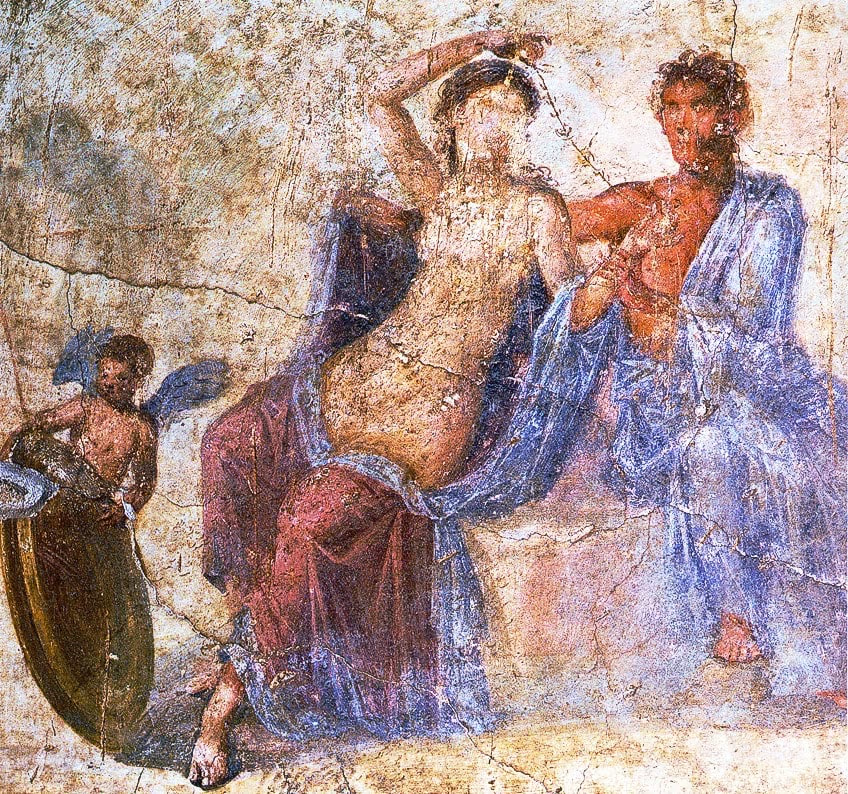
Real imported marble was common in official spaces and temples as wall decor. This act of imitation allowed local people to add a burst of color and prestige to their homes. Many Roman wall paintings were created using multiple layers of material and are described by Pliny the Elder and Vitruvius as follows: The artist first applies a base coat of mortar on the wall surface, which can be layered up to three times in thickness. The coating is made up of lime and either volcanic pozzolana or sand.
After this, an additional three coats are added on top but this time the mixture consists of finely pulverized marble and lime for a smooth finish.
The next layer is glass and marble, after which cloth would be used to polish the marble in preparation for painting. While the surface remained wet, the pigment was added, and this is known as fresco. Other details were later added once the surface dried and this is referred to as tempera. For wooden surfaces, colors were first dissolved in hot wax and then applied to the wall surface with a spatula.
Frescoes of the Villa of P. Fannius Synistor
Located just north of Pompeii, Boscoreale was the hotspot of aristocracy and was even nicknamed “the royal forest” for its reputation as a hunting preserve for the wealthy. The villa was constructed not long after the turn of the middle of the first century and was rediscovered around the early 1900s. The decorated walls at the villa were created around 40 and 30 BC and are an indication of the owner’s taste and appreciation for the antiquity of the frescoes.
Many of the surviving artworks showcase the second style of ancient Roman art and contain many visual ambiguities in addition to architectural details that are rendered to resemble real architectural elements.
These include columns, pillars, and rusticated masonry. The shadows cast by the pillars and columns fall into the viewer’s space and also include three-dimensional meanders. Objects that featured in daily life also appeared on the ancient Roman wall paintings and included objects such as glass vases and tables that appeared to protrude from the wall. It is said that the owner probably wished to impress his guests at the villa by presenting such detailed and illusionary features on the frescoes.

The Roman aristocrats also relied upon the inspiration derived from the arts and culture of the Hellenistic period. The inspiration for the grandiose lifestyle of the Roman aristocracy originated from the Greeks of the East who also served as a source of ideas for Roman architecture, decorations, art, and education.
Below, we will look at a few famous wall paintings from the villa of P. Fannius Synistor, which was completely submerged under the molten aftermath of the eruption of Mt. Vesuvius.
Room M: Cubiculum (Bedroom)
| Date | c. 50 – 40 BCE |
| Period | Late Republic |
| Medium | Fresco |
| Dimensions (cm) | 265.4 x 334 x 583.9 |
| Where It Is Housed | Metropolitan Museum of Art, New York City |
This bedroom is located in Room M of the villa of P. Fannius Synistor, with each wall divided into four sections. The imagery on the fresco on the rear wall depicts a rocky landscape with an arbor above it and a cave that shelters a fountain. A small figure portraying Hekate can also be seen below.
Between the two columns in the middle of the wall is a parapet decorated with a yellow landscape that supports a transparent bowl containing fruit.

The four sections of the wall are divided by a pilaster, which adds definition to the two columns and couch area. The frescoes showcase enclosed courtyards where one can catch imagery of pylons, rotundas, and vegetation. These frescoes were unearthed by Vincenzo de Prisco between 1899 and 1900.
Room H: Seated Woman Playing a Kithara
| Date | c. 50 – 40 BCE |
| Period | Late Republic |
| Medium | Fresco |
| Dimensions (cm) | 186.7 x 186.7 |
| Where It Is Housed | Metropolitan Museum of Art, New York City |
Seen in Room H of the villa, this fresco depicts a woman sitting on a chair, playing a kithara in the middle of what is allegedly the triclinium (dining area) or the social room. The frescoes in this room are said to have originated from Greek traditions in art known as megalographia, or in more familiar terms, large-scale painting. The woman, dubbed the kithara player, is adorned in a purple chaiton with a white himation.
Her jewelry consists of a headband, a bracelet, and earrings, which all appear to be gold. Her kithara appears gilded and indicates that she is a professional kithara player.
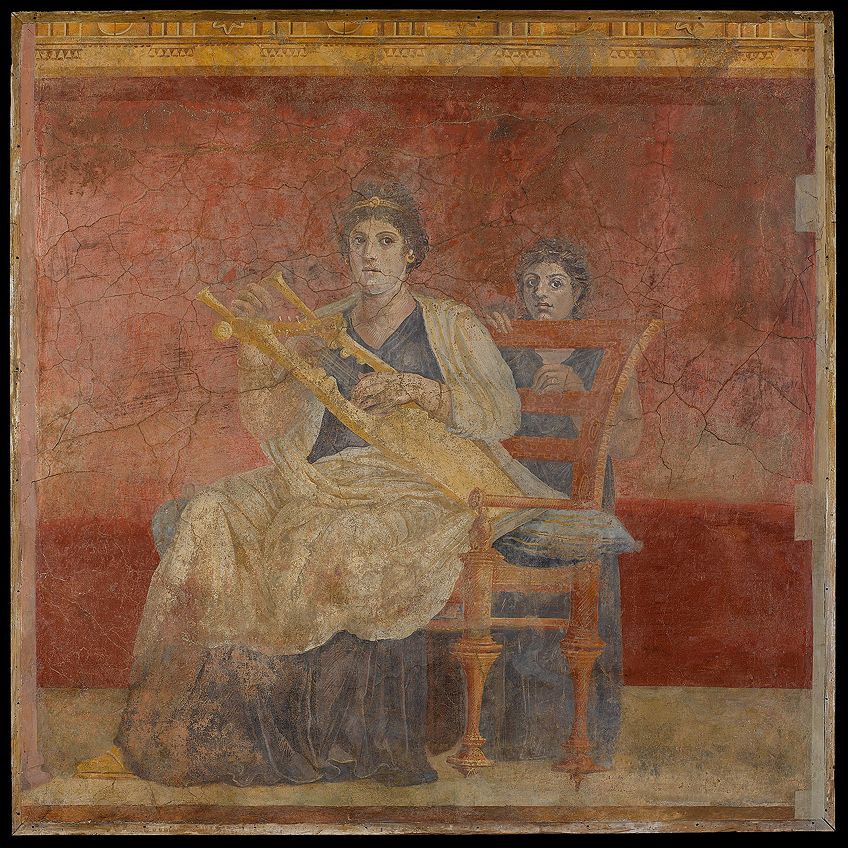
The smaller figure of Atlas provides support for the arms of the once deep-red-lacquered chair. The other living subject in the fresco is a young girl dressed in a sleeveless purple chiton with similar gold jewelry to that of the kithara player.
The detail in which the gold jewelry is rendered is said to allude to the visual characteristics of a royal personage.
According to the most recent theories, it has been suggested that the subjects depict a Macedonian queen and her daughter or perhaps a young princess. The gaze cast by both the young girl and the kithara player is positioned directly toward the viewer, who is also the spectator.
Room H: Man and Woman Seated Side by Side
| Date | c. 50 – 40 BCE |
| Period | Late Republic |
| Medium | Fresco |
| Dimensions (cm) | 175.3 x 193 |
| Where It Is Housed | Metropolitan Museum of Art, New York |
Taken from the grand triclinium, this fresco scene, found in Room H of the villa, depicts a man and a woman sitting next to each other. The man is depicted as naked and this is considered a classic display of heroic nudity while the woman, who is assumed to be his wife, is portrayed as pensive.
This was a common depiction of many married women in ancient Roman art.
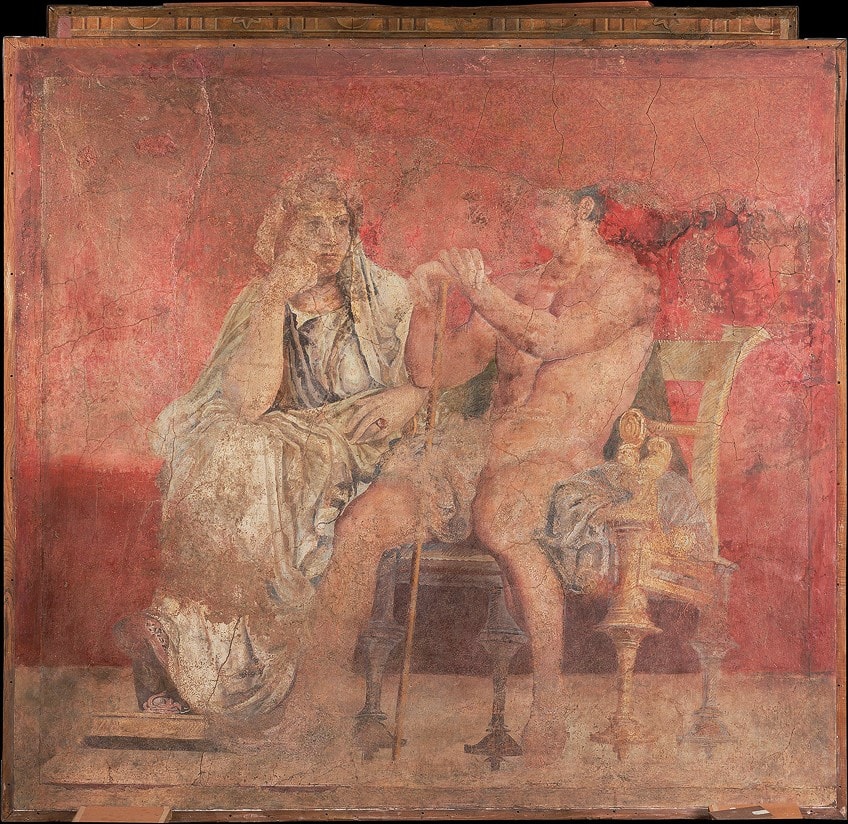
Ixion Room Frescoes at the House of the Vettii
| Date | First century CE |
| Medium | Fresco |
| Size (m²) | 1100 |
| Where It Is Housed | House of the Vetii, Pompeii, Italy |
The Ixion room contains multiple frescoes executed in the intricate style of the middle of the first century CE in Pompeii. These frescoes are a great example of the culmination of artistic expression in Pompeii wall paintings. The Ixion room contains faux blocks of marble lined up against the base of the walls to frame the naturalistic scenes. The frescoes also combine flat planes of color with architectural details and central panel images.
According to Pliny the Elder, the style expressed in these frescoes was developed by a painter called Famulus, who was also responsible for the decor in Nero’s Golden Palace.
The main attraction of the Ixion room is the display of Greek mythological scenes and intricate mosaics. As in the name, Ixion, who is known as the king of the Lapiths, is seen in a fresco that depicts a scene where Ixion is being punished and Hermes makes a suggestion for his punishment – to be chained to a fiery wheel.

Ixion was to be punished by Zeus for attempting to win over the affections of Hera. Hera can be seen seated on a throne, listening to another woman who pleads on behalf of Ixion. The Ixion room found in the House of the Vettii is also one of the most popular sites for anyone studying the antiquities of ancient Rome.
The unique home was owned by Aulus Vettius Conviva and Aulus Vettius Restitutus, both brothers who accumulated a large sum of wealth as merchants.
One of the brothers, Vettius Conviva also held a very high rank in the civic office. Their new home, the house of Vettii was then remodeled by one workshop for around 19 years. The paintings of the Ixion room also feature chiaroscuro-style shading, which adds depth and three-dimensionality to the artwork.
The God of Fertility: Priapus Fresco
| Date | First century CE |
| Medium | Fresco |
| Dimensions (cm) | Unavailable |
| Where It Is Housed | House of the Vetii, Pompeii, Italy |
Also found in the house of the Vettii is another famous partial wall painting of the God of fertility, Priapus, who is represented as weighing his enlarged penis against a bag of money. This painting was situated at the entrance of the villa, which indicated the level of importance this fresco had for the brothers.
Priapus was also an apotropaic effigy and was used as a symbol of protection to ward off the evil eye and protect the household from invisible evil forces.

There is also a statue in the garden of the fertility God, which also served as a makeshift scarecrow. In the fresco, one sees the God weighing his phallus against gold but his penis is also directed at the basket of fruit, which draws attention to where value is placed. The owners were aware of the meaning behind the painting and the value of the relationships between nature’s produce, fertility, and earning money.
Other paintings found at the house of the Vettii include erotic scenes near the slaves’ quarters, images of serpents symbolizing the genius and intellect of the homeowners, and many cupids found throughout the villa.
Villa di Giulia Felice: Terentius Neo and His Wife
| Date | c. 60 CE |
| Medium | Fresco |
| Dimensions (cm) | Unavailable |
| Where It Is Housed | Archaeological Museum of Naples |
This Roman fresco from the villa of di Guilia Felice portrays Terentius Neo clutching a scroll and posing with his wife who is seen holding a writing tablet and a stylus. Family portraits were common in ancient Roman paintings of Pompeii and the portrait here is sometimes up for debate on whether the subjects are, in fact, Terentius Neo and his wife.
The woman in the painting appears to be dressed in a red garment and some argue that the stylus may have been an applicator for makeup as opposed to its writing use on a wax tablet.
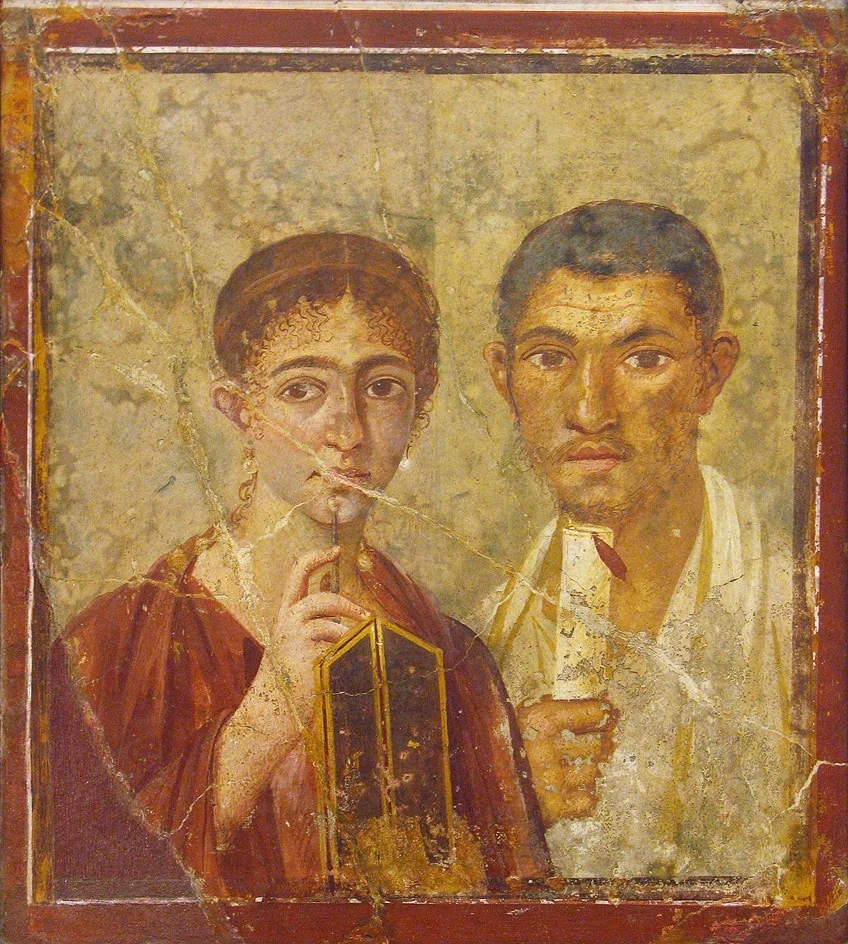
The Fayum Portraits: Portrait of a Man Wearing a Laurel Wreath
| Date | c. 101 – 150 CE |
| Period | Roman Empire |
| Medium | Lime (linden) wood, beeswax, pigments, gold, textile, natural resin |
| Dimensions (cm) | 39.4 x 22 x 0.2 |
| Where It Is Housed | Art Institute Chicago |
Also recognized as the Fayum mummy portraits, these naturalistic paintings were made in Egypt under Roman rule and were part of the mummification process. Originally, portraits held their place on wooden boards but this transitioned to mummies and the portraits were painted using a mixture of pigments with beeswax and laid over the faces of the dead.
In this portrait, the deceased man has heavily lidded eyes and full lips, which showcase his individuality.
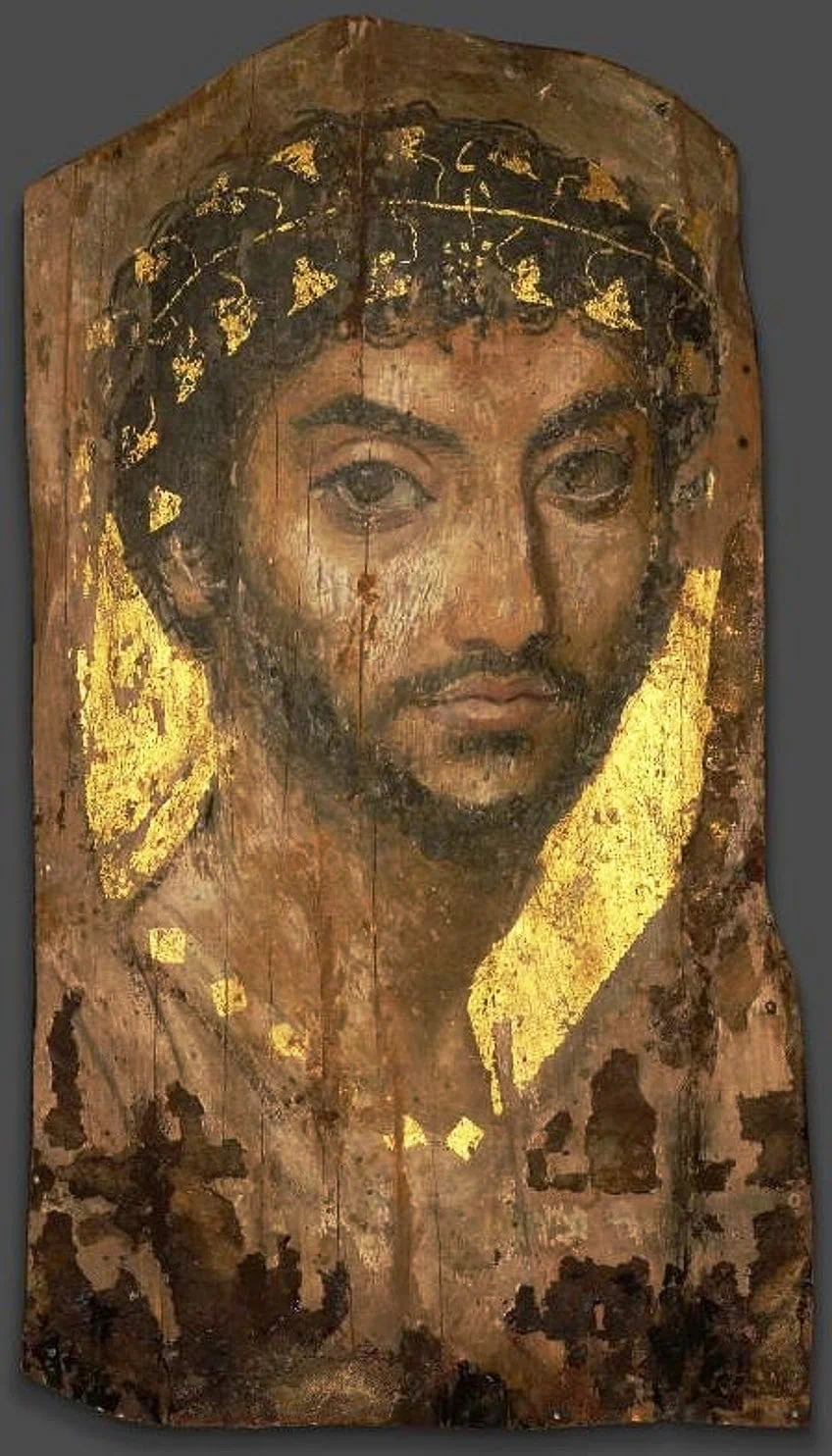
His facial hair is painted as neatly trimmed in a style characteristic of the Roman trend of the time. The addition of gold also serves as a symbol of divinity and immortality, which mirror the effort and expense put into this lavish display, soon to be hidden away.
The Catacomb of Via Latina: Daniel in the Lions’ Den
| Date | c. Mid-4th century |
| Medium | Fresco |
| Dimensions (cm) | Unavailable |
| Where It Is Housed | Catacomb of Via Latina, Rome |
The Roman Catacombs are not only known to be one of the largest ancient burial sites from the ancient world but are also the site of the artistic wonders of the first Christian artists of fourth-century Rome. Many frescoes in the catacombs immortalize various scenes from the bible, including the fresco above derived from the biblical account of Daniel and his encounter in the lions’ den.
The frescoes of the catacombs also combine Christian themes with imagery from Pagan beliefs.
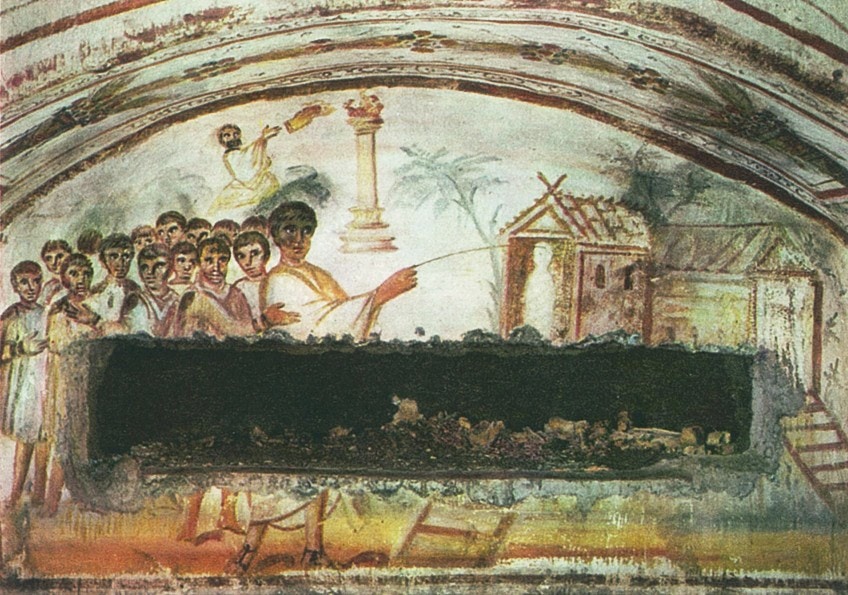
Out of the many wall paintings, frescoes, and tempera artworks believed to exist in ancient Rome, these are just some of the few surviving artworks that give us a glimpse into the artistic techniques and interests of the time. The Greeks also played a role in influencing Roman artwork as many Etruscan artists received commissions from their Roman fans. The impact of ancient Roman art on art history served as a gateway for future artists to learn from and highlighted to ancient creatives that art could be made in different forms, other than painting.
Take a look at our Roman paintings webstory here!
Frequently Asked Questions
What Techniques Were Used in Ancient Roman Paintings?
Some painting techniques found in ancient Roman paintings include the decorative coating of stucco; fresco, which involves wet paint is applied directly onto laid lime plaster; and tempera, which is the application of paint on a dry surface. The wall paintings of ancient Rome contained many layers and varied in visual style from Realism and Impressionism to highly detailed images.
What Are the Four Styles of Ancient Roman Painting?
The four styles of ancient Roman painting are classified by their visual characteristics. The first style involved the use of a middle space divided into three sections, a frieze, and a cornice, all of which were also characteristics of classic architecture. Here, stucco was also applied for three-dimensionality, especially on cornices of wall paintings. The second style of painting involved painted columns and the presence of an architrave and pediment, which framed the inner imagery of the paintings. Paintings executed in this style contain religious and ceremonial imagery and are often perspectival. The third style of painting is defined by the architectural definition and detail of decorative elements. Dominant colors in this style include yellow, red, and black and there is more emphasis on symmetry. The fourth style is incredibly decorative and features a transition to whiter backgrounds, the addition of more stripes, lines, and more large-scale single-scene imagery.
What Are the Four Types of Ancient Roman Art?
The four types of Roman art from ancient Rome to the Roman Empire include painting, mosaics, architecture, and sculpture.
What Traits Define Roman Paintings?
Roman artwork emphasized naturalistic depictions, including landscapes and imagery from mythology, and literature. Colors associated with Roman paintings include black, dark red, violet, yellow, and green.
Jordan Anthony is a Cape Town-based film photographer, curator, and arts writer. She holds a Bachelor of Art in Fine Arts from the University of the Witwatersrand, Johannesburg, where she explored themes like healing, identity, dreams, and intuitive creation in her Contemporary art practice. Jordan has collaborated with various local art institutions, including the KZNSA Gallery in Durban, the Turbine Art Fair, and the Wits Art Museum. Her photography focuses on abstract color manipulations, portraiture, candid shots, and urban landscapes. She’s intrigued by philosophy, memory, and esotericism, drawing inspiration from Surrealism, Fluxus, and ancient civilizations, as well as childhood influences and found objects. Jordan is working for artfilemagazine since 2022 and writes blog posts about art history and photography.
Learn more about Jordan Anthony and about us.
Cite this Article
Jordan, Anthony, “Famous Roman Paintings – Discover Ancient Roman Art Pieces.” artfilemagazine – Your Online Art Source. September 7, 2022. URL: https://artfilemagazine.com/famous-roman-paintings/
Anthony, J. (2022, 7 September). Famous Roman Paintings – Discover Ancient Roman Art Pieces. artfilemagazine – Your Online Art Source. https://artfilemagazine.com/famous-roman-paintings/
Anthony, Jordan. “Famous Roman Paintings – Discover Ancient Roman Art Pieces.” artfilemagazine – Your Online Art Source, September 7, 2022. https://artfilemagazine.com/famous-roman-paintings/.


